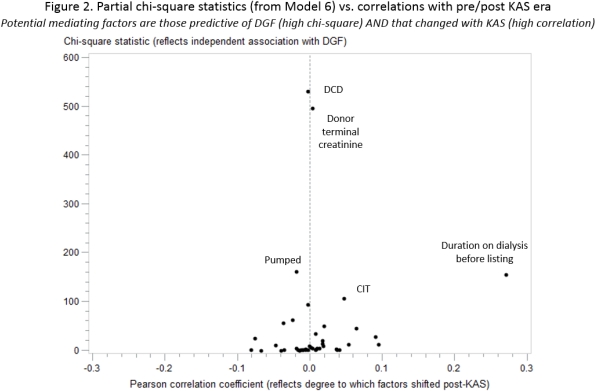Understanding the Drivers Behind an Early Post-KAS Rise in Delayed Graft Function (DGF) Rates.
UNOS, Richmond, VA.
Meeting: 2016 American Transplant Congress
Abstract number: 97
Keywords: Allocation, Graft function, Kidney transplantation, Post-operative complications
Session Information
Session Name: Concurrent Session: Delayed Graft Function and Protocol Biopsy
Session Type: Concurrent Session
Date: Sunday, June 12, 2016
Session Time: 4:30pm-6:00pm
 Presentation Time: 4:30pm-4:42pm
Presentation Time: 4:30pm-4:42pm
Location: Room 302
Background: DGF among solitary deceased donor kidney transplants (tx) increased by 22% (p<0.0001) — from 24.6% to 30.1% — during the first 6 months of KAS. This study sought to identify the underlying causes of the increase such as the possible impact of more kidneys being shipped under KAS.
Methods: We used logistic regression with OPTN data to perform effect mediation analysis to determine which donor, recipient, and logistics-related factors help to explain the apparent KAS effect on the DGF rate. Pre-KAS era: 12/4/13-12/3/14 (n=11,566 solitary deceased donor kidney transplants), Post-KAS: 12/4/14-5/31/15 (n=5,732).
Results: The post-KAS increase in the DGF rate – odds ratio=1.38 (95% CI: 1.28, 1.49) – was not explained at all by shifts in donor factors (e.g., age, creatinine, DCD, comorbidities), % glomerulosclerosis on biopsy findings, whether the kidney was pumped, most recipient factors, or donor-recipient matching factors. Increased shipping distance and CIT had very little mediating effect. However, adjusting for candidate duration on dialysis explained more than half of the KAS effect, reducing the residual post/pre-KAS odds ratio to 1.16 (1.06, 1.27). (Fig 1)

Potential mediating factors of the KAS effect are those that are (a) independently and strongly associated with DGF and (b) changed significantly with KAS. Fig 2 reveals duration on dialysis prior to listing as the only such factor, with CIT only moderately associated with DGF and correlated with pre/post KAS.

Conclusions: The early post-KAS rise in DGF appears to be largely, but not entirely, explained by more post-KAS recipients having had long dialysis durations. As transplants to these patients taper due to initial bolus effects, the national DGF rate may decrease. After accounting for traditional factors used to model DGF, a residual (unexplained) KAS effect remains. Further monitoring and analyses will be performed.
CITATION INFORMATION: Stewart D, Kucheryavaya A, Klassen D. Understanding the Drivers Behind an Early Post-KAS Rise in Delayed Graft Function (DGF) Rates. Am J Transplant. 2016;16 (suppl 3).
To cite this abstract in AMA style:
Stewart D, Kucheryavaya A, Klassen D. Understanding the Drivers Behind an Early Post-KAS Rise in Delayed Graft Function (DGF) Rates. [abstract]. Am J Transplant. 2016; 16 (suppl 3). https://atcmeetingabstracts.com/abstract/understanding-the-drivers-behind-an-early-post-kas-rise-in-delayed-graft-function-dgf-rates/. Accessed December 15, 2025.« Back to 2016 American Transplant Congress
